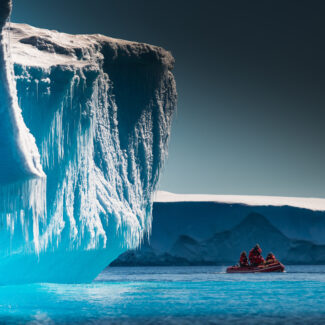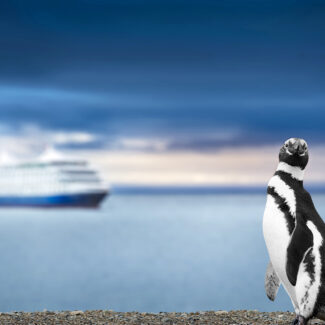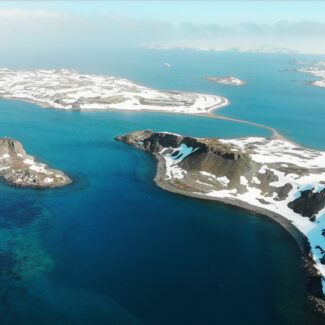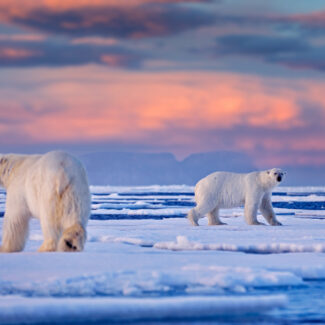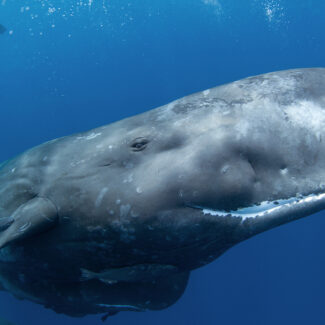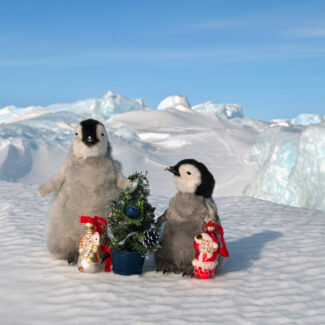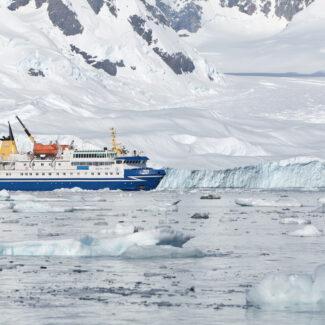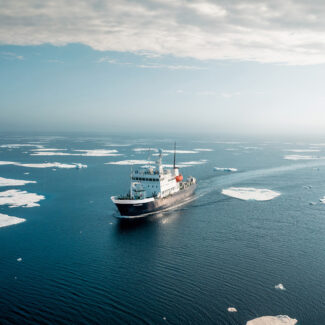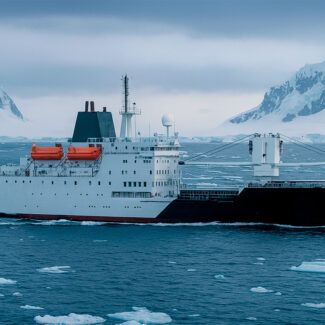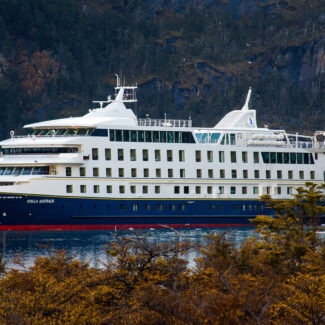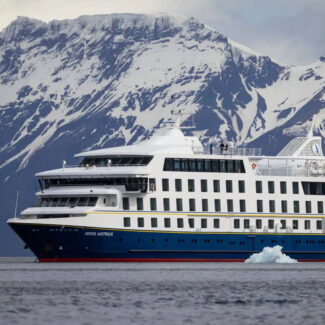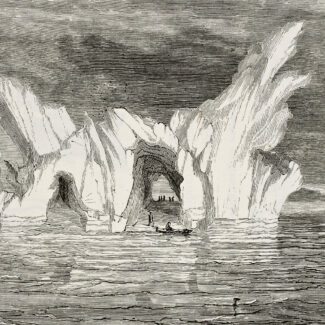No, I am the Walrus: 10 Whimsical Facts About Walruses
- (1) There Are Two Defined Subspecies of Walrus
- (2) Walruses Have Been Extirpated From Some of Their Former Haunts—Including Ones Surprisingly Far South
- (3) Walrus Size: They Rank Among the Biggest of All Pinnipeds
- (4) They Mostly Feed on Bottom-Dwelling Marine Invertebrates, and Their Famous “Moustache” Comes in Handy For This
- (5) The Walrus’s Famous Tusks Serve Multiple Purposes
- (6) The Tusks Aren’t the Only Super-Impressive Anatomical Features of the Male Walrus
- (7) Walruses Make Significant Seasonal Movements, and Rely on Open Water & Haulouts
- (8) They Sometimes Go A-Wanderin’
- (9) Orcas & Polar Bears Are Threats, But Walruses Are No Pushovers
- (10) They Are a Keystone Species in the Arctic
- Where to See Walruses
The portly, wrinkled, resplendently tusked walrus has had an outsized presence in global human culture, when one considers its extreme northerly and mostly very remote geographic purview. This huge pinniped, after all, plays a starring and titular role in one of Lewis Carroll’s most beloved writings, “The Walrus & the Carpenter,” a poem (in Through the Looking Glass) which provided the inspiration for John Lennon’s psychedelic Beatles hit (from Magical Mystery Tour) “I Am the Walrus.” (The accompanying video for the latter memorably showed the Fab Four songwriter garbed up as the sea-beast.) The animal’s striking appearance—similarly as, say, the gloriously gangly giraffe or the pouched and hoppy kangaroo—likely accounts for the walrus’s steady and regular cameos in stories, drawings, music, and other art all across the world.
From their famous tusks to their curious whiskers, walruses are one of the most unique and fascinating creatures in the Arctic, with a story far more whimsical than you might think.
To Native peoples of the Arctic, the walrus was and is much more than a delightful oddity, serving as an important natural resource—its meat eaten, its ivory rendered into tools and art, its hides used to cover boats—and a valued member of the Far North ecosystem. And indeed it is an ecological linchpin, as you’ll learn about in the following 10 interesting facts about walruses!
(1) There Are Two Defined Subspecies of Walrus
Scientists have classified two distinct subspecies of walrus: the Pacific walrus and the Atlantic walrus. Of the two, the Atlantic walrus is slightly smaller, and its tusks tend to be a bit stubbier and its snout a bit flatter as compared to its Pacific cousin. These days, Atlantic walruses are also significantly less numerous than Pacific walruses, which account for roughly 90 percent of the species, population-wise, these days.
Atlantic walruses range from the eastern Canadian Arctic and Greenland into the Norwegian and Russian Arctic, including Svalbard and Franz Josef Land. The Pacific walrus primarily inhabits the continental shelves of the Bering and Chukchi seas of Russia and Alaska, also peripheries of the Siberian and Beaufort seas, and with an isolated, far-westerly stock in Russia’s Laptev Sea. (That Laptev Sea population was once thought to constitute its own walrus subspecies, but today taxonomists reckon it’s a population of Pacific walruses that was, quite likely, historically connected to the rest of that subspecies’s stock.)
While the walrus is easy to recognize, it’s a bit trickier to tell the subspecies apart. Their primary difference is geographic, with one found in the Pacific and the other in the Atlantic.
(2) Walruses Have Been Extirpated From Some of Their Former Haunts—Including Ones Surprisingly Far South
The ranges of both the Pacific and Atlantic subspecies have contracted in the past several centuries (and beyond) on account of excessive walrus hunting by humans, who’ve long prized the animals’ tusks, hides, and blubber. Commercial harvest of walruses ramped up in the mid- to late 1800s, partly as an offshoot of the whaling industry, which by then was majorly depleting stocks of the great whales and therefore looking for alternative sources of oil and other products.
But local extirpations of walruses by humankind predated that intense era. The Atlantic walrus, for example, once inhabited Iceland, but Norse hunters, keen on ivory, eliminated that population by about a thousand years ago. It also formerly hauled-out in large numbers on isolated Sable Island in the North Atlantic, roughly 100 miles off the Nova Scotian coast, and occasionally strayed into the Gulf of Maine—cold-temperate waters from which the walrus is now absent.
While these walruses are a common sight in the remote Arctic, populations were historically found much further south. Their return to these areas is a testament to conservation efforts.
(3) Walrus Size: They Rank Among the Biggest of All Pinnipeds
Occupying their own lonesome genus within the pinniped line, which also includes seals and sea lions, walruses are outsized among this marine-mammal branch only by the two species of elephant seal (the enormous northern elephant seal and the even-more-enormous southern elephant seal). And given pinnipeds reside in the mammalian order Carnivora, this technically makes the walrus the third-biggest carnivore on Earth—sometimes substantially bigger than the largest terrestrial carnivores, which are polar and brown bears. (Keep in mind that any meat-eating organism—including critters such as orcas and sperm whales that are heftier yet than these hulking pinnipeds—may be called a carnivore; we’re talking here, again, about the so-named taxonomic order of mammals.)
While Atlantic walrus bulls commonly weigh on the order of a ton or so, male Pacific walruses may exceed 4,000 pounds; they sometimes stretch a dozen feet long or so from whiskery snout to hindflippers. As in many pinnipeds, female walruses are much smaller than males, but still heavyweights by any objective measure, clocking in at anywhere from about 900 pounds to more than a ton in the case of the Pacific subspecies.
Walruses are just generally burly, with thick, knobby skin—it may be 10 centimeters thick around the neck and shoulders of bulls—and thick blubber underneath.
This magnificent bull walrus can weigh as much as a small car, making them a true heavyweight of the Arctic and one of the largest pinnipeds on Earth.
(4) They Mostly Feed on Bottom-Dwelling Marine Invertebrates, and Their Famous “Moustache” Comes in Handy For This
The bulk of walrus diet in most areas is made up of benthic (bottom-dwelling) marine invertebrates: most especially bivalves such as clams, but also aquatic worms, crabs, and the like. The hundreds of stiff whiskers, or vibrissae, which give the walrus a moustached visage—and which explains the name of the thick, curling “walrus moustache” worn by some men—help the walrus sense vibrations and direct contact with objects as it snuffles along the seabed. Upon keying into a clam, mussel, or other morsel, the walrus uses the impressive suction mechanisms of its mouth to ingest the soft parts of its prey.
Walruses mainly do their seafloor-foraging in relatively shallow water over continental shelves: While they’re capable of diving past 500 meters (1,640 feet), they much more commonly make dives of 100 meters (328 feet) or less.
Although shellfish and other invertebrates are the number-one fare, other animals do land on the walrus’s menu. Fish are sometimes taken, and so are seabirds: One walrus in Nunavut, Canada apparently scarfed down nearly 70 thick-billed murres in a single (hungry) day. Some walruses—particularly (but not exclusively) large bulls—will also hunt seals, including ringed, bearded, and spotted seals. That powerful suction action, so effective in consuming invertebrates, appears to also help walruses remove meat and organs from the carcasses of birds and seals, which they may first start to dismantle via violent thrashing and which may end up essentially turned inside out.
Walrus have even been rumored to occasionally attack narwhals that are trapped in sea ice, though to what extent that happens isn’t clear.
While it may look like a whimsical mustache, the walrus’s sensitive whiskers are an essential tool, helping it forage for its favorite foods on the seafloor.
(5) The Walrus’s Famous Tusks Serve Multiple Purposes
The most iconic feature of the walrus is surely its pair of tusks. Both bulls and cows grow these cartoonishly oversized canine teeth, though the tusks of males tend to be longer and thicker than those of females. These curved daggers are the source of the much-coveted walrus ivory, harvested for millennia by Arctic Natives and also a hot global trade commodity in historical times.
The walrus tusk serves multiple functions. For one thing, both male and female walruses will use tusks to break through thin ice and thereby create breathing holes; to anchor themselves at breathing holes; and for traction as they drag themselves up onto the ice. (That latter use likely explains part of the walrus’s rather wild Latin name: Odobenus rosmarus, which translates to “tooth-walking sea-horse.”) Walrus bulls also brandish tusks as a show of dominance, and may employ them in contests with rivals.
While walruses apparently don’t really use their tusks while foraging for benthic bivalves—as mentioned, the vibrissae and lips are really the main tools for that—they will do so when preying on seals: There are well-documented observations of walruses striking and stabbing at seals with their tusks. And certainly tusks can serve as defensive weapons when confronted by predators (more on that in a bit).
The walrus’s tusks are a true multi-tool of the Arctic, used for everything from hauling out onto ice and digging for food to establishing dominance and self-defense.
(6) The Tusks Aren’t the Only Super-Impressive Anatomical Features of the Male Walrus
At first glance, we might suppose those big tusks are the most outstanding physical characteristic of a bull walrus. Actually, there’s another bone that’s technically even more impressive, stacked up against the rest of the animal kingdom: the walrus’s (ahem) penis bone, aka its os penis, aka its baculum. The baculum of the male walrus is by a fair measure the largest among mammals, both in absolute size and in proportional relation to the rest of the body. It may exceed 60 centimeters (2 feet) in length.
As the Natural History Museum of London’s Principal Curator of Mammals Richard Sabin explains, baculums are found among certain species across a diverse collection of mammals, including carnivores, primates (though not humans), rodents, and bats. The purpose of the penis bone isn’t entirely known, though it may help prevent cross-species hybridization (the baculum is shaped specifically to correspond to the female of that species), provoke ovulation, and provide general rigidity. Sabin noted that, given the major sexual dimorphism seen in walruses, the walrus penis bone may also simply help the much larger male target the right area in the female. The size and hardness of the walrus baculum also at least partly explains why walrus romance goes down in the water; mating ashore might risk breaking the bone, considering the huge bulk of these animals.
With the largest baculum in the animal kingdom, the male walrus has another claim to fame besides his tusks. A symbol of their virility and strength, this unique bone can measure up to two feet long.
(7) Walruses Make Significant Seasonal Movements, and Rely on Open Water & Haulouts
Different walrus stocks make extensive movements or, essentially, migrations throughout the course of the year. These travels, which tend to be at least somewhat sexually segregated for part of the calendar, are tied to habitat and foraging needs. Shallow continental-shelf waters rich in their preferred prey and ready access to sea ice as well as coastal shorelines for haulouts are among the key habitat features for walruses. In terms of sea ice, the animals need thick-enough ice to support their weight but not too extensive ice coverage as to restrict their movements, hamper diving, or trap them; they require ample leads and polynyas (open-water holes) within the sea ice. The ideal sea-ice habitat for walruses has been described as “broken pack,” with more angular as opposed to circular ice floes most ideal on account the former, in dense concentrations, provide more open-water area.
Female walruses and their young are particularly tied to sea ice across the year, at least when it’s available and accessible, and they’ll often migrate north as spring and summer commences to follow the retreating pack. Indeed, the sea ice provides the preferred birthing platform for mother walruses. Male walruses are found among the pack ice in winter, which is the breeding season, but in summer will often forage more in ice-free waters, relying on islands and coastlines for haulouts. The expansion of sea ice as autumn sets in sees female and young walruses head southward to stay within zones of ideal ice coverage and thickness.
Pacific walruses in the Beringia region of Siberia and Alaska serve as an example of this kind of seasonal round. In winter, they tend to congregate in the west-central portion of the Bering Sea between St. Lawrence Island and the Gulf of Anadyr as well as farther east in Bristol Bay, the two wintering grounds being separated by a less-favorable realm of “rounded” (as opposed to broken) pack. Female walruses and juveniles head north with the fallback of sea ice in spring, and mainly spend the summer, including calving time, in the Chukchi Sea north of the Bering Strait; while most adult bulls continue hanging out in the Bering Sea along the Chukchi Peninsula, Gulf of Anadyr, and Bristol Bay, using land-based haulouts. In fall, as the annual sea ice forms and pushes southward, walrus cows and young animals head south accordingly.
While sea ice provides the preferred surface for walruses to rest and give birth, haulouts on islands and seashores are definitely important in many areas, and tend to be used again and again across walrus generations. Some of these haulouts may host hundreds or thousands of walruses at a time.
Essential to their seasonal movements, haulouts are crucial resting and breeding spots for walruses, which rely on the health of the Arctic’s sea ice and open water to survive.
(8) They Sometimes Go A-Wanderin’
Animals seen well outside their normal geographic range are called “vagrants,” and they often draw plenty of attention. That’s certainly been true of vagrant walruses. Capable of swimming long distances (as their annual movements attest) and also, perhaps, riding errant ice floes on improbable journeys, walruses have shown up far south of the Arctic on multiple occasions.
In 2021, for example, “Wally” the walrus drew international media coverage when he took an apparent sightseeing tour through the British Isles—hanging out along the coasts of Ireland, Wales, and England—and as far as the shores of France and Spain.
Indeed, a 2024 review published in Polar Biology estimated that more than 30 vagrant walruses were documented in temperate Europe—that is, below 61 degrees N latitude—between 1922 and 2022, and suggested that the majority of these animals probably hailed from the Norwegian Arctic archipelago of Svalbard, with maybe a handful originating in Greenland. The majority of these walrus sightings came from the British Isles and Denmark. The analysis noted an increase in vagrant walruses in temperate European waters across that timeframe.
Vagrant Atlantic walruses have also been recorded south of their normal haunts on the coasts of Canada (there’s a 1937 record of a big male Atlantic walrus being killed by fishermen in the Bay of Fundy, for example) and the northeastern U.S., while there are records of wayward Pacific walruses showing up in Japanese waters.
We have less of a sense of vagrant walruses north of their usual range—not surprising, given how sparsely populated the top of the world is. But there are several records of walruses showing up at around 82 degrees North, and, in 2018, a walrus bull in apparently good condition was photographed above 89 degrees North, within shouting distance of the North Pole. As a report on that extreme sighting notes, the very deep waters of the Arctic Ocean at these latitudes don’t offer good foraging habitat for the shallow-diving, invertebrate-eating walrus, so they’re unlikely to become a habitual hangout.
While these magnificent marine mammals are usually found in the Arctic, some will occasionally wander far from home, showing up in unexpected places to the surprise of onlookers.
(9) Orcas & Polar Bears Are Threats, But Walruses Are No Pushovers
Aside from humans, walruses face only two major natural predators: the orca (or killer whale) and the polar bear. Yet adult walruses, thanks to their large size and those spikelike tusks, are formidable adversaries, and both orcas and bears risk injury attacking them. Indeed, polar bears probably only rarely tackle full-grown walruses, more commonly targeting calves. Bears may attempt to stampede hauled-out walrus herds in hopes that calves are either left behind or trampled to death. Additionally, there’s intriguing evidence, gathered both from Traditional Ecological Knowledge (TEK) of Inuit peoples and recent scientific inquiry, that polar bears in at least certain areas may sometimes try to kill walruses by hurling stones or chunks of ice at their heads—if legit, an example of ursid tool use. The thickness of walrus hide and skulls makes it challenging for a bear to bite into the braincase, compelling, perhaps, some “ice bears” to get creative.
Scientists have actively documented orca predation on walruses in some areas, including a 2008 observation of a killer-whale pod attacking a herd along the Chukotkan coast. In this case, orcas thrashed into shallow water in their pursuit of panicked walruses, and ended up singling out a young animal from the herd that was then subjected to a prolonged attack—with orcas striking it with flukes and head and also pushing it underwater—whose ultimate outcome was unknown. The researchers who observed this incident theorized it was likely a training exercise designed to teach the orca calves present some predatory techniques.
While orcas have certainly been observed preying on walruses, it’s worth noting that some Arctic TEK suggests killer whales may be leery or even afraid of these well-armed pinnipeds. A 2013 study published in Arctic, which interviewed Inuit in 11 Nunavut communities about their attitudes toward and understanding of orcas, reported that more than 30 interviewees in nine different communities mentioned the whales being fearful of walruses. Some of the interviewees suggested orcas could be spooked away from an area by humans wielding walrus tusks or analogously white items (even coffee cups!), and several pointed to accounts of orcas being killed by walruses, including an observation of a walrus impaling a killer whale with its tusks and both animals ultimately perishing.
The polar bear is a formidable predator, but this standoff shows why walruses are no easy meal. Their size and powerful tusks make them a dangerous opponent.
(10) They Are a Keystone Species in the Arctic
The walrus is more than simply an emblematic figurehead of the Arctic: It’s a keystone species up here. That means it exerts an especially profound influence on the rest of the ecological web, just by going about its daily life.
How so? Well, for one thing, the benthic foraging of walruses—muzzling and slurping their way along the seabed—stirs up a lot of sediment, which ends up releasing otherwise buried nutrients, decaying organic matter, and various tiny organisms such as fish and crustacean larvae into the water column. This walrus “bioturbation,” as it’s technically called, nutrifies the sea and fuels bacterial breakdown and primary production, producing a ripple effect of enrichment and a structuring influence throughout the marine (and, ultimately, terrestrial) food web. Given how many hours a day a walrus spends foraging, and how much territory falls within the domain of the species, the bioturbation ramifies big-time across Arctic seas. Considered locally, it’s thought the benthic disturbance performed by walruses translates to perhaps two-thirds’ greater nutrient release from seafloor sediments than otherwise would occur.
Furthermore, walruses influence the Arctic marine ecosystem simply by consuming an awful lot of nosh. Scientists have estimated that Pacific walruses in Beringia throw back some three million metric tons of benthic prey each year.
The profound ecological role walruses perform across their circumpolar range raises concerns about the effect climate change will have—and is having—on the pinniped. Reductions in sea-ice cover, thickness, and duration may limit walruses’ access to their prime feeding grounds and force the animals to rely more and more on terrestrial as opposed to on-ice haulouts, which may expose them to greater disturbance from humankind as well as perhaps heightened threat of polar-bear predation.
Also, it may mean more and more walruses in an area are utilizing particular coastal haulouts, increasing the likelihood of overcrowding—which, as has been documented before, can increase trampling mortality among walrus calves. And that’s not even going into the potential effects of warming ocean temperatures and marine acidification upon walruses themselves and the things they like to eat.
By disturbing the seabed as they forage for food, the walrus plays an essential role in the Arctic ecosystem, influencing the health and biodiversity of the entire marine environment.
Where to See Walruses
While walruses—sometimes historically referred to as “sea-oxen”—are reasonably common in zoos and aquaria, the vast majority of people have never clapped eyes on these marvelous giants in the wild. A cruise to the Arctic gives you that rare opportunity.
Walruses can be seen year-round in many parts of the Arctic. Our Arctic cruises give you plentiful opportunities to potentially spy Atlantic walruses in their summertime haunts, from Svalbard to Greenland and the Canadian Arctic. Sightings are never guaranteed, but these amazing routes thread you through some prime walrus territory!
To see these incredible animals up close, you must travel to the far reaches of the Arctic, where they gather on the sea ice of places like Svalbard and Greenland.
Disclaimer
Our travel guides are for informational purposes only. While we aim to provide accurate and up-to-date information, Antarctica Cruises makes no representations as to the accuracy or completeness of any information in our guides or found by following any link on this site.
Antarctica Cruises cannot and will not accept responsibility for any omissions or inaccuracies, or for any consequences arising therefrom, including any losses, injuries, or damages resulting from the display or use of this information.


